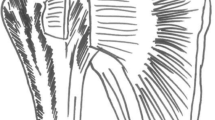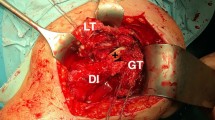Abstract
Purpose
In the case of reverse shoulder arthroplasty (RSA) for proximal humeral fractures (PHFs) with tuberosity reconstruction, it is unclear whether the supraspinatus tendon continues to play a role. The aim of this study was to evaluate the clinical and radiological outcomes of RSA for PHFs in a large cohort of elderly patients and compare the results in the case of supraspinatus excision or preservation.
Methods
In this retrospective multicentre study, 150 patients (mean age 77 years, 93% female) were reviewed and radiographed with a minimum follow-up of 24 months. The same Grammont prosthetic design was used in all cases (inclination angle 155°, non-lateralised glenosphere). Patients were divided into two groups: Group A (n = 117) underwent supraspinatus excision and Group B supraspinatus preservation (n = 33). Complications were recorded, and shoulder function, active mobility and subjective results were assessed.
Results
At a mean follow-up of 59 months, there was no statistical difference in the complication rate (6% vs. 6.8%, p = 1), mean Constant score (61 points vs. 59 points, p = 0.52), simple shoulder value (74% vs. 73.9%, p = 0.9), active anterior elevation (125° vs. 128°, p = 0.45) and internal rotation (4.9 points vs. 4.1 points, p = 0.2). However, mean active external rotation was better in Group A (22° vs. 13°, p = 0.01). The greater tuberosity healing rate in satisfactory position did not differ statistically between the groups (68% vs. 55%, p = 0.14).
Conclusion
In the case of RSA with tuberosity reconstruction for acute PHFs, there is no clear evidence that supraspinatus preservation is advantageous.
Similar content being viewed by others
References
Chen L, Xing F, Xiang Z (2016) Effectiveness and safety of interventions for treating adults with displaced proximal humeral fracture: a network meta-analysis and systematic review. PLoS ONE 1:e0166801. https://doi.org/10.1371/journal.pone.0166801
Chun YM, Kim DS, Lee DH, Shin SJ (2017) Reverse shoulder arthroplasty for four-part proximal humerus fracture in elderly patients: can a healed tuberosity improve the functional outcomes? J Shoulder Elbow Surg 26:1216–1221. https://doi.org/10.1016/j.jse.2016.11.034
Gallinet D, Adam A, Gasse N, Rochet S, Obert L (2013) Improvement in shoulder rotation in complex shoulder fractures treated by reverse shoulder arthroplasty. J Shoulder Elbow Surg 22:38–44. https://doi.org/10.1016/j.jse.2012.03.011
Ohl X, Bonnevialle N, Gallinet D, Ramdane N, Valenti P, Decroocq L et al (2018) How the greater tuberosity affects clinical outcomes after reverse shoulder arthroplasty for proximal humeral fractures. J Shoulder Elbow Surg 27:2139–2144. https://doi.org/10.1016/j.jse.2018.05.030
Boileau P, Watkinson D, Hatzidakis AM, Hovorka I (2006) Neer award 2005: the Grammont reverse shoulder prosthesis: results in cuff tear arthritis, fracture sequelae, and revision arthroplasty. J Shoulder Elbow Surg 15:527–540. https://doi.org/10.1016/j.jse.2006.01.003
Sirveaux F, Roche O, Molé D (2010) Shoulder arthroplasty for acute proximal humerus fracture. Orthop Traumatol Surg Res 96:683–694. https://doi.org/10.1016/j.otsr.2010.07.001
Boileau P, Krishnan SG, Tinsi L, Walch G, Coste JS, Mole D (2002) Tuberosity malposition and migration: reasons for poor outcomes after hemiarthroplasty for displaced fractures of the proximal humerus. J Shoulder Elbow Surg 11:401–412. https://doi.org/10.1067/mse.2002.124527
Constant CR, Gerber C, Emery RJ, Sojbjerg JO, Gohlke F, Boileau P (2008) A review of the Constant score: modifications and guidelines for its use. J Shoulder Elbow Surg 17:355–361. https://doi.org/10.1016/j.jse.2007.06.022
Gilbart MK, Gerber C (2007) Comparison of the subjective shoulder value and the Constant score. J Shoulder Elbow Surg 16:717–721. https://doi.org/10.1016/j.jse.2007.02.123
Sirveaux F, Favard L, Oudet D, Huquet D, Walch G, Molé D (2004) Grammont inverted total shoulder arthroplasty in the treatment of glenohumeral osteoarthritis with massive rupture of the cuff. Results of a multicentre study of 80 shoulders. J Bone Jt Surg Br 86:388–395
Berhouet J, Garaud P, Favard L (2013) Influence of glenoid component design and humeral component retroversion on internal and external rotation in reverse shoulder arthroplasty: a cadaver study. Orthop Traumatol Surg Res 99:887–894. https://doi.org/10.1016/j.otsr.2013.08.008
Mollon B, Mahure SA, Roche CP, Zuckerman JD (2016) Impact of glenosphere size on clinical outcomes after reverse total shoulder arthroplasty: an analysis of 297 shoulders. J Shoulder Elbow Surg 25:763–771. https://doi.org/10.1016/j.jse.2015.10.027
Müller AM, Born M, Jung C, Flury M, Kolling C, Schwyzer HK et al (2018) Glenosphere size in reverse shoulder arthroplasty: is larger better for external rotation and abduction strength? J Shoulder Elbow Surg 27:44–52. https://doi.org/10.1016/j.jse.2017.06.002
Anakwenze OA, Zoller S, Ahmad CS, Levine WN (2014) Reverse shoulder arthroplasty for acute proximal humerus fractures: a systematic review. J Shoulder Elbow Surg 23:e73–e80. https://doi.org/10.1016/j.jse.2013.09.012
Bacle G, Nové-Josserand L, Garaud P, Walch G (2017) Long-term outcomes of reverse total shoulder arthroplasty: a follow-up of a previous study. J Bone Jt Surg Am 99:454–461. https://doi.org/10.2106/JBJS.16.00223
Cazeneuve JF, Cristofari DJ (2011) Long term functional outcome following reverse shoulder arthroplasty in the elderly. Orthop Traumatol Surg Res 97:583–589. https://doi.org/10.1016/j.otsr.2011.03.025
Ross M, Hope B, Stokes A, Peters SE, McLeod I, Duke PF (2015) Reverse shoulder arthroplasty for the treatment of three-part and four-part proximal humeral fractures in the elderly. J Shoulder Elbow Surg 24:215–222. https://doi.org/10.1016/j.jse.2014.05.022
Lévigne C, Garret J, Boileau P, Alami G, Favard L, Walch G (2011) Scapular notching in reverse shoulder arthroplasty: is it important to avoid it and how? Clin Orthop Relat Res 469:2512–2520. https://doi.org/10.1007/s11999-010-1695-8
Lignel A, Berhouet J, Loirat MA, Collin P, Thomazeau H, Gallinet D et al (2018) Reverse shoulder arthroplasty for proximal humerus fractures: is the glenoid implant problematic? Orthop Traumatol Surg Res 104:773–777. https://doi.org/10.1016/j.otsr.2018.06.008
Florschütz AV, Lane PD, Crosby LA (2015) Infection after primary anatomic versus primary reverse total shoulder arthroplasty. J Shoulder Elbow Surg 24:1296–1301. https://doi.org/10.1016/j.jse.2014.12.036
Funding
There is no funding source.
Author information
Authors and Affiliations
Corresponding author
Ethics declarations
Conflict of interest
Nicolas Bonnevialle, Philippe Clavert, Luc Favard, Pascal Boileau received from Tornier Wright honorarium as consultant, Laurent Obert received from FX Solutions honorarium as consultant and Christophe Chantelot received from Evolutis honorarium as consultant. The other authors declare that they have no conflict of interest.
Ethical approval
Approved CCTIRS-16-003
Informed consent
Informed consent was obtained from all individual participants included in the study.
Additional information
Publisher's Note
Springer Nature remains neutral with regard to jurisdictional claims in published maps and institutional affiliations.
Rights and permissions
About this article
Cite this article
Bonnevialle, N., Ohl, X., Clavert, P. et al. Should the supraspinatus tendon be excised in the case of reverse shoulder arthroplasty for fracture?. Eur J Orthop Surg Traumatol 30, 231–235 (2020). https://doi.org/10.1007/s00590-019-02572-7
Received:
Accepted:
Published:
Issue Date:
DOI: https://doi.org/10.1007/s00590-019-02572-7




